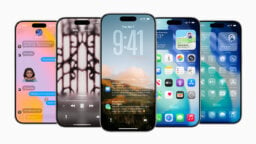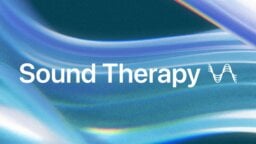Spatial Audio is quickly evolving from an audiophile pursuit to a mainstream audio format.
Stereo, which delivers audio from two channels to mainly create a left or right-directional sense of where the music is being played from, replaced Mono as the dominant format around the late sixties to early seventies.
Audio has evolved yet again since then, with Dolby Surround becoming a mass market phenomenon with the rise of high-end home cinema.
In music, Spatial Audio (powered by Dolby Atmos technology for example) delivers a more immersive experience than Stereo, and sounds like the different parts of a recording are coming from all directions around the listener.
“People who listen to a decent Dolby Atmos mix for the very first time are often blown away by this new listening experience,” says Matthias Stalter, founder and CEO of ThreeDee Music, a company that specializes in Spatial Audio production.
“Even skeptics have to admit how much more vivid and natural music sounds in 3D formats,” Stalter adds. “There are more and more products launched that are capable of Dolby Atmos, from mobile devices to sound bars up to car entertainment systems and many more.”
“This market is rapidly growing and it is foreseeable that music in 3D has the potential to replace Stereo just as Stereo did with Mono almost 50 years ago.”
One of the clearest signs of Spatial Audio’s potential mass-market adoption arrived in 2021 when Apple Music rolled out this format with support for Dolby Atmos, free for all of its subscribers.
The platform revealed in January this year that more than 80% of its worldwide subscriber base listened to Spatial Audio in 2022.
As interest in the format increases, and the market for Dolby-Atmos-supported technology grows, so too has the need for studios that specialize in producing music in Spatial Audio.
ThreeDee Music was launched by Stalter in 2021. He was previously based at London’s iconic Abbey Road Studios, where he was one of only two full-time in-house producers with their own production suites (the other being Giles Martin, son of Beatles producer Sir George Martin).
Stalter says he started to recognize Spatial Audio’s potential in the music business. He claims that “it was obvious” that, just as Stereo replaced Mono after it was introduced, “it would only be a question of time until Spatial Audio would become the new standard”.
At the same time, he realized that the production of music for 3D formats was still in its infancy. “Achieving the same standards of quality for those formats as for Stereo would be a challenge for an industry that had not yet spent the time on developing suitable processes and techniques for producing music in Spatial Audio,” he says.
Stalter explains that he decided “to become one of the pioneers in this field” and get a head start on developing methods, tools, and techniques for music production for Spatial Audio from writing and arranging, to recording, mixing, and mastering.
ThreeDee Music now serves as a consultant on new audio formats, and the company also offers services from recording to mixing and mastering in a way specifically optimized for music in 3D.
The company operates from certified studios, one in London, and the other in Munich, Germany. “For our studios, top-of-the-line recording and mixing equipment has been selected – from the analog as well as the digital realm, and for both 3D and Stereo,” says Stalter.
In addition to Stalter as CEO, ThreeDee Music’s team (of which there are 10 members in total) includes Studio Manager and Chief Mixing Engineer, Christoph Thiers, and Gregor Stöckl, the company’s Head of Key Account Management, who is a former Head of Marketing for Domestic at Warner Music Central Europe, and prior to that a Managing Director of Virgin Records in Germany.
ThreeDee recently signed a deal with Universal Music Germany for the GSA area for Dolby Atmos mixes across a large number of the company’s frontline releases, but also part of its back catalog.
Stalter notes that a “major part” of ThreeDee Music’s latest work stems from the deal it signed with Universal Music in Germany. He adds that the company has mixed more than 250 tracks in Spatial Audio over the past couple of months.
A major development at ThreeDee Music in recent months is the company’s own ‘ThreeDee PRO’ app Version II.
The app lets B2B users, currently around 500 of them, listen to and approve their Dolby Atmos material remotely. Stalter explains that the app is designed for iOS and uses Apple’s own “binauralizer” to play back Dolby Atmos material from their clients’ iPhones/iPads.
The company says that its ThreeDee PRO app gives its clients the “crucial and unique possibility to listen, compare and approve Spatial Audio mixes exactly how they will sound on Apple Music, Amazon Music and Tidal after release”.
Looking to the future of the Spatial Audio space, Stalter stresses that “Dolby Atmos is not just a gimmick”.
“Music in 3D has the potential to replace Stereo,” he adds.
Here, Stalter gives us his predictions for the Spatial Audio business, and explains how ThreeDee Music is situated in the sector…
How is ThreeDee Music positioned in the 3D Audio space and what differentiates you from your competitors?
ThreeDee Music has had a huge head start as a pioneer in the Spatial Audio business. When Dolby Atmos started to emerge as the potential future standard format – after the announcement from Apple back in 2021, that they have implemented this format (especially for headphones) on their Apple Music platform – many have tried to jump on the bandwagon and add Dolby Atmos mixing to their own studio services, or even opened new studio spaces that they declared as Dolby Atmos mixing studios.
However, the quality of the results can vary dramatically. There are plenty of studios that deliver decent results, but there are also some that have yet to develop their services to the full potential that music in 3D can offer. If you don’t have years of experience in Spatial Audio production, you will not even be able to scratch the surface of what Dolby Atmos is capable of doing.
However we have mixed hundreds of tracks with our own holistic approach to Spatial Audio production, which includes several unique methods that put us way ahead of the competition. In some cases we are also involved in the writing and arranging process of the material to make optimal use of the whole three-dimensional acoustic space. During the recording phase, we apply novel processes and various techniques that we have developed specifically to capture signals optimized for Spatial Audio production.
“The creative possibilities of the format need to be understood, just like they had to be learned and understood when Stereo was introduced back in the day.”
During the mixing stage, we use the acoustic canvas of the space provided by Dolby Atmos to really make the songs work in this particular format. Dolby Atmos is not just a gimmick to play with, where you position and move things in space, just because you can. The creative possibilities of the format need to be understood, just like they had to be learned and understood when Stereo was introduced back in the day. Our very early adoption of the format did give us a head start in this process that does set us apart.
We are also able to provide unparalleled excellence in a very short time frame. Our fast turnaround times stem from efficient processes which we plan to scale up further within the next few months to be completely prepared for the growing number of clients we will take on in the very near future. This is an important aspect in our industry, where things need to be completed at very short notice, to extremely tight deadlines.
Mercedes-Benz for example is continuously working on optimizing their in-car entertainment – this will become even more apparent and meaningful as self-driving cars are most definitely where our future is heading, giving the passenger more time to relax and enjoy all the entertainment on offer in these new vehicles.
Listening to music in Dolby Atmos has been fully integrated into this new generation of cars and we will be in the very privileged position soon of having our own showcase car, to demonstrate these productions in said environment to our clients, where our productions of their music can be fully approved and enjoyed in the comfort of a Mercedes-Benz.
We are also in constant and continuous contact with Dolby UK and Germany and there is mutual feedback on the development and use of the Atmos format.
You have developed an app that lets your clients approve Dolby Atmos mixes without having to visit the studio. Why was the app developed and how popular has it been?
The motivation for developing ThreeDee PRO was to offer our clients a convenient solution to audition their music in 3D formats prior to release. There is currently no other solution for music creators to receive their music via a simple download code straight to a dedicated app for checking their Spatial Audio material and comparing it with Stereo mixes from their iPhone/iPad with supported headphones.
With the free ThreeDee PRO app, we provide this option for our clients at zero cost. So it’s about the simplicity of the feedback process, the ease of use and the speed of communication – and thus the economic efficiency. Our clients really like it and the app is quickly gaining popularity. Currently, we have around 500 active B2B users (artists, producers, A&Rs, product managers, record labels, etc.) and the number keeps growing constantly.
You’re currently working on multiple album projects. Tell us about how these projects came about and what was the brief for it individually?
Recently we have finalized the Dolby Atmos version of Moby’s new album Resound NYC. Most of the artists we work with have come to us through the recommendation of their individual labels or managers, as well as the usual business introductions.
We also do generate interest through word of mouth which has thus proven to be a successful process and our clients are always extremely happy with the results we deliver. A very revealing key performance indicator is the rate of revisions that a producer/mixer receives from artists; having sent hundreds of tracks to our clients, we are looking at a revision rate lower than 2%! This is absolutely outstanding and shows the excellence of quality we are aiming for.
What are the biggest challenges in the 3D Audio space?
Originally, surround formats were developed for multi-speaker setups. 3D takes these surround formats a step further by adding a third axis as an additional direction. But these setups always have the potential to create phase issues and the results might ruin a mix. It takes quite some skill and experience to maneuver through this. Nowadays, most consumers of Spatial Audio listen to music over headphones, and translating the sound to this playback system can also be a challenge.
It becomes even more complicated since the “binauralizers”, which enable the effect of immersion to be created through only two earplugs, are under continuous development to achieve a better sounding, a more “natural” experience for the listener. That means algorithms are changing, and therefore the sound of the material being played back is changing accordingly. Here we are again at the forefront of the development because of our feedback about binauralizer related topics to Dolby. This continuous exchange helps us make our Dolby Atmos productions sound excellent in all iterations of the platform and thus future-proof.
“Nowadays, most consumers of Spatial Audio listen to music over headphones, and translating the sound to this playback system can also be a challenge.”
“Binauralizers” for the playback of music in Dolby Atmos over headphones also need to add certain components like reverberation or equalization that not every musical style or sound benefits from. The aforementioned problems will also arise when translated to other devices that are Dolby Atmos capable, like sound-bars for home theaters. Cars have their own acoustic properties that need to be accounted for – here again, our business relationships with direct contacts at Mercedes-Benz, Dolby and Apple are a big plus for our clients.
Especially for back catalog material – if there are no single tracks or stems available – we have dedicated state-of-the-art AI tools that can extract single stems from Stereo or even Mono mixes, which we can then isolate and use to create an actual Spatial Audio mix. We can do this very convincingly as we have experimented a lot with various technologies and taken old tracks from the middle of the 20th century, separated them into isolated stems and created Dolby Atmos mixes that we played to a broad range of test listeners. Those were often not able to tell the difference between these mixes and current Dolby Atmos productions. Even though some studios already offer de-mix services, I believe we have an edge over the competition with our proprietary technology, delivering better quality at a lower price point. As good as it is now, it can be expected that this AI technology will make significant further progress in the upcoming years.
What are the biggest misconceptions about the 3D Audio space?
The first common misconception is that Spatial Audio is just some technical gimmick. Many are treating the format like it is the latest fad only and throw their music into the ring just for the sake of it. Or they create a bad mix where they route a few signals onto different surround configuration outputs and call it 3D, while it is actually far from being a real piece of Spatial Audio.
Or treating it like a toy and playing around with it, without having a concept of what has to be achieved from an artistic point of view. I’ve heard mixes where sound elements have been placed at inappropriate positions in the surround field or have even been moved in a way that just does not make much sense musically. That is simply not how it works – as everything else in a musical context, positions, movements, etc. need to have a purpose and serve the music itself, instead of the mix just being a means to demonstrate what a cool new technological gadget you’ve just discovered.
Also, this kind of approach to mixing in Dolby Atmos has sadly created some misconceptions among listeners. There are plenty of people who listened to such tracks – partly by well-known artists – and rightfully decided that the specific song sounds better in Stereo and instantly discarded the format. These hastily emerged misconceptions need to be corrected, not in the least by releasing and exposing listeners to excellent music in 3D where the format supports not only the artistic and creative vision but also the purpose which in turn brings the experience and enjoyment to a whole new level.
If there was one thing about the music industry you could change, what would it be and why?
There definitely is a strange paradox around our business: Music plays a major role in our lives. We could hardly live without it, and in each decade we often connect important events with certain songs – and probably “the soundtrack of our youth”, whatever music we grew up with, also shaped our character and the way we look at the world. In other words: Music is vital. But at the same time, people do not want to pay for it and show little monetary appreciation for something that is this important to them. To help solve these issues, not the consumer, but the industry needs to be approached, and as many ideas as possible should be put forward to remedy the situation in some way. Change is definitely needed.
“Music is vital. But at the same time, people do not want to pay for it and show little monetary appreciation for something that is this important to them.”
Nobody ever doubts or undervalues the amount of effort and hard work a Lawyer, Doctor or Teacher puts into their work, and ultimately based on these facts, nobody would usually put [these professions’] monetary worth into doubt or undervalue it. However, when it comes to music, everything has to be cheap or even free. Unfortunately, even inside the industry, a bad attitude exists towards the value of music.
Artists don’t want to pay much for studio time anymore, club owners don’t want to pay bands for gigs anymore, and so it goes on. Whoever creates good art delivers an important contribution to our lives and wellbeing and deserves to be paid fairly. Don’t get me wrong, we know that not everybody’s dream can come true. I am talking about those artists who put their effort in, make the necessary sacrifices and above all are truly good at what they do. They deserve to be paid far more than what is currently on offer. We need to rediscover the huge contribution of each individual artist and ultimately the worth of music in our personal lives.
I totally agree with what Merck Mercuriadis, founder and CEO of Hipgnosis Songs, said [in an interview by Vikas Shah, published on February 27, 2019 in Thought Economics]:
[Mercuriadis] said: “I have always believed that hit songs and music, art in general, has real value to it. What people don’t really recognise is that when a song becomes a proven song, the earnings pattern to it becomes very predictable and reliable, and is therefore investable. And these songs are as valuable as gold, or oil.”
We don’t get anything for free at the gas station or the jewelers, do we? And so therefore, it begs the question, why should it be any different at the “digital record store”.Music Business Worldwide







